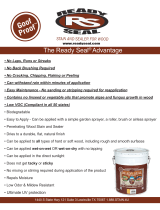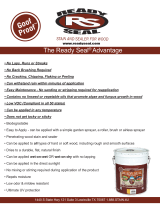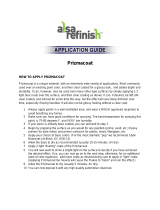
Doors can be stained either hanging in the opening or removed from the
frame
(recommended). Should you remove the door, take care to protect
it from damage. Sidelites will need to be finished vertically. To remove
the door from the frame, use a pin punch and hammer. Strike the hinge
pin from the bottom until it pops up (for outswing units – hinge leaf must
be removed from the door). Drive the hinge pin as far as possible with
the punch. Using a pair of pliers, grasp the hinge pin and, while twisting,
pull the pin out. Remove all door hardware.
IMPORTANT
Please read and understand the entire painting procedure before attempting to finish
the door. Be sure to follow the paint and top-coat manufacturers detailed application
instructions on the product label.
These painting instructions apply to the following Masonite products: Belleville
®
Smooth,
VistaGrande Smooth, Heritage Smooth, Masonite
®
HD Steel, Sta-Tru
®
HD Steel and Barrington
®
.
Note: Painting instructions specifically refer to the door and sidelite panels. Oil-based paint
should not be used on wood frame components (frames & brickmould).
PRECAUTIONS AND SAFETY BEFORE STARTING THE FINISHING:
u
Never mix cleaners or solvents. This may be dangerous as well as ineffective.
u
If using commercial cleaning or finishing products or solvents, carefully read and follow
safety instructions, warnings, cautions and disposal instructions on manufacturer’s
labels. Wear appropriate safety gear (e.g. clothing, goggles, gloves) and provide plenty
of ventilation.
u
Immediately clean spills.
u
Most solvents are flammable and/or toxic and must be handled with extreme care. Do
not use near open flame, sparks, or electrical motors.
HOW TO
START
PREPARING THE
DOOR SURFACE
PAINTING
THE DOOR
1
2
3
IMPORTANT: For adequate paint adhesion, the door surface must be free of dust, debris
and other surface contaminants.
Steel doors should be wiped clean with a solvent such as mineral spirits or acetone. Make
sure to clean the edges, recesses and corners as much as possible. This will help to remove
the residual contaminants which directly helps to get a better finish with no defects in the
future. Allow the cleaning solvent to dry completely – until there is no residual odor. Once
wiped clean, the door must be lightly sanded with a 220-grit sandpaper. After sanding, the
door must be washed with a mild detergent in warm soapy water, rinsed and then dried.
Fiberglass doors should be wiped clean with a solvent such as mineral spirits or acetone.
Allow the cleaning solvent to dry completely – until there is no residual odor. Next, the door
must be washed with a mild detergent in warm soapy water, rinsed and then dried. Mask
(tape) off all surfaces that will not be painted, including all glass.
Use exterior, high quality, oil-based or 100% acrylic water-based latex paint of desired
color. High quality interior paint can be used on the interior surface of the door only.
Lacquer paints are not recommended. Follow the manufacturer’s instructions for paint
application by using either a brush or a handheld sprayer.
PAINTING
Put on gloves, safety glasses and prepare your materials. Before starting, and
occasionally throughout the project, stir the paint using smooth strokes until
the texture is creamy – avoid creating bubbles.
1-800-663-DOOR masonite.com
How to Paint
STEEL & FIBERGLASS ENTRY SYSTEMS
OPTIMAL CONDITIONS
Find a well-lit painting location that is
dust-free, well-ventilated and within
the climate conditions recommended
by the coating manufacturer.
Recommended temperature should
be between 50°F-90°F (10°C-32°C).
MATERIALS NEEDED
COATINGS & ACCESSORIES:
u
Mineral spirits or acetone
u
One pair of rubber gloves
u
Mild detergent in warm water
u
Stir sticks
u
Masking tape
u
Safety razor blades
u
Paint
– High-quality, oil-base or 100%
acrylicwater-based latex paint
of desired color
– Do not use lacquer paints
– Semi-transparent stains are not
recommended
u
2-1/2” wide brush appropriate for
type of paint (a natural bristle brush
should be used with oil-based paint
and a synthetic bristle brush should
be used with latex paint.)
u
200 grit sandpaper
TOOLS
u
Hammer
u
Pin punch
u
Safety glasses
u
Phillips screwdriver
u
Pliers
u
Air-less sprayer (optional)
MASONITE HD STEEL
®
HIGH-DEFINITION STEEL ENTRY DOORS
BARRINGTON
®
ULTIMATE STYLE & DURABILITY
BELLEVILLE
®
DISTINCT ARCHITECTURAL DETAILS
OAKCRAFT
®
WOOD GRAIN TEXTURED
MIC-18124 / ©2018 Masonite International Corporation.
MIC-18124-PaintStain-Instructions.indd 3 7/5/18 12:07 PM








